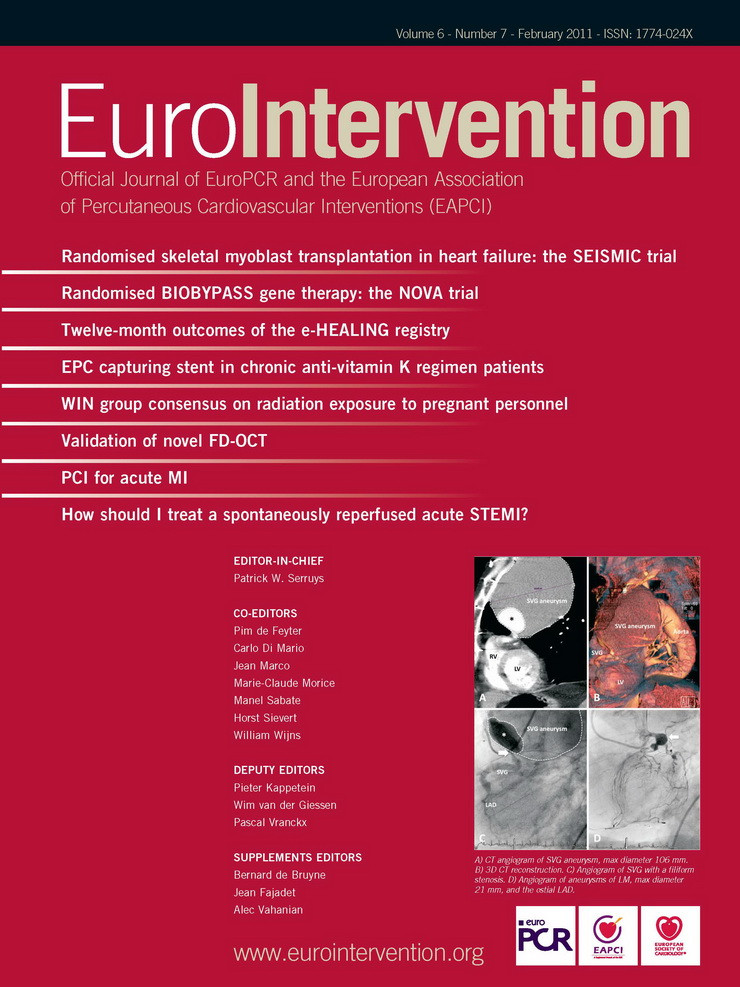We have read with great interest the article written by Godino et al about the results of the paclitaxel-eluting stent in left main lesions1. In the era of bare metal stents percutaneous intervention in left main disease was considered an exceptional procedure and as the first manifestation of restenosis in left main lesions might be sudden cardiac death, it was mandatory to perform an angiographic follow-up at 2-4 months to detect this potential complication2. In the current era, the progressive utilisation of drug eluting stents, their dramatic reduction in restenosis rate and the publication of several non-randomised series underlying the successful results of left main stenting have motivated that left main stenting has become the routine approach of revascularisation in many centres, despite the type IIb recommendation in the guidelines for percutaneous intervention3,4 and the better results obtained with surgery in randomised trials such as SYNTAX. However, we should not forget the need of the angiographic follow-up. In Godino´s series with angiographic follow-up at six months as many as 30.1% patients needed target vessel revascularisation and in the group of bifurcated lesions this percentage reached 38.2%. Only 11 of the 24 target lesion revascularisations were driven by clinical symptoms and meaning that the remaining 13 (54.1%) would continue with the left main lesion if the angiographic follow-up would have not been performed. Although it is well known that the angiographic follow-up increases the rates of new revascularisation, it is not less true that in left main disease the threshold to perform revascularisation should be lower. We believe that if the interventional community wants to compete with the surgical techniques and especially when the guidelines do not support the percutaneous intervention we are obligated to offer our best, and this includes the angiographic follow-up after every procedure of left main stenting.
I can understand the concerns of these authors and the suggested importance to perform angiographic follow-up in all patients treated by PCI for unprotected left main stenosis regardless of clinical symptoms. As reported by our group1 more than 50% of patients with LMT restenosis were asymptomatic. Considering the low sensitivity and specificity of stress testing in identifying myocardial ischaemia related to LMT restenosis, it is not uncommon to observe instances of sudden clinical events in the context of these lesions (e.g., NSTEMI and sudden death). It is therefore our internal protocol to perform angiographic follow-up at 4-6 months. However, at the moment, the data is not sufficient to support the need to perform elective angiographic follow-up to all patients treated by PCI for unprotected left main stenosis. In the Le MANS registry2 only 141/252 patients (56%) underwent control coronary angiography six to 12 months after the index procedure. Despite this, at 3.8 years follow-up, the incidence of cardiovascular adverse events was not that elevated: 11% cardiac death, 9.9% myocardial infarction, 8.3% target lesion revascularisation. Moreover, considering the possibility of a late in-stent restenosis, when we should perform the angiographic follow-up, is still open to question.
Currently, we advise that a CT scan can be performed, as an alternative to coronary angiography, when an invasive test is refused by the patient or contraindicated. However, in the future it may be that the development of myocardial CT-scanning elevates this test as our primary follow-up imaging modality for these patients. In short, after performing high-risk left main stenting, it is a shame to lose our hard work for the sake of avoiding a follow-up angiogram or a coronary CT scan.

